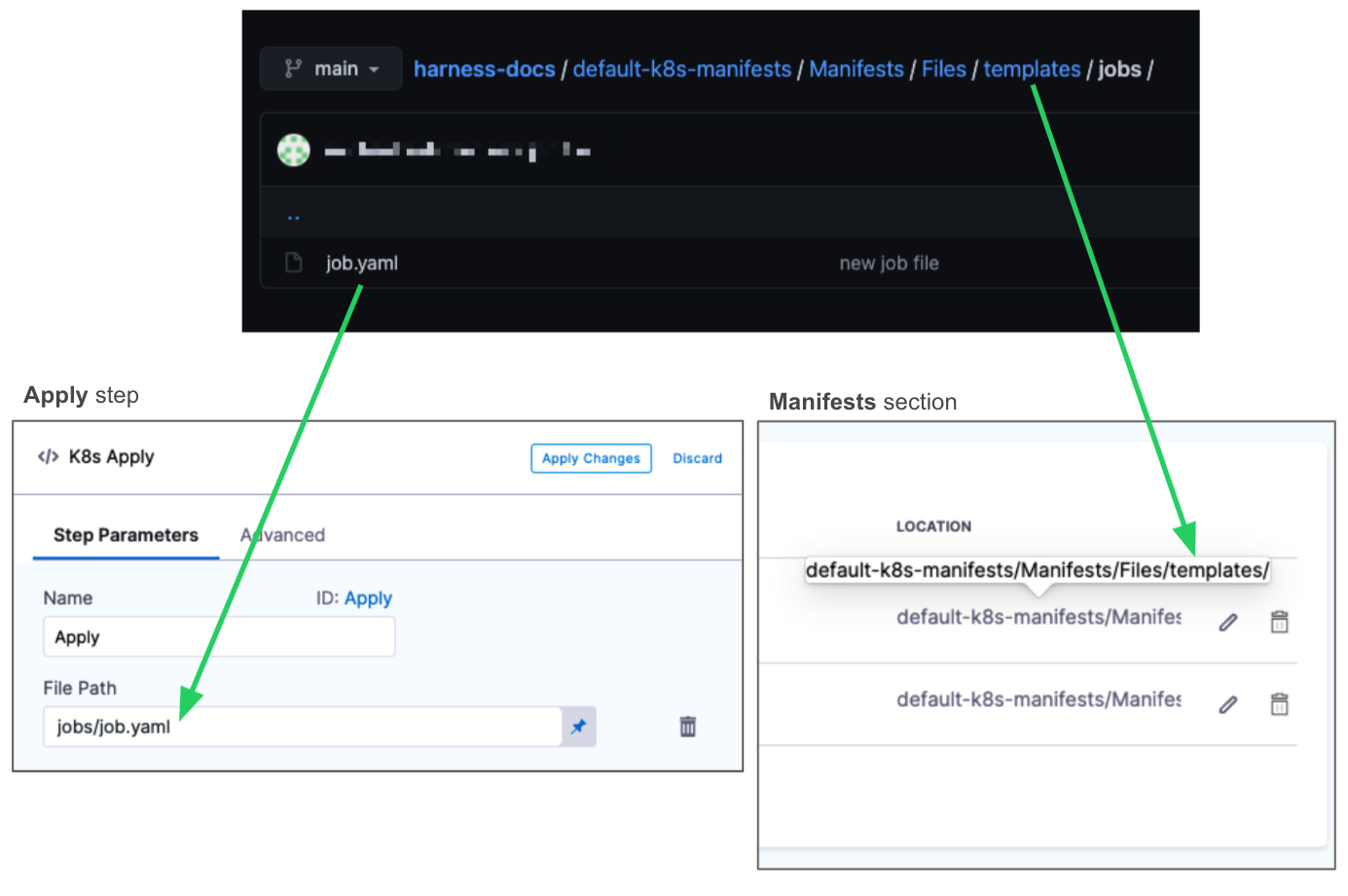Kubernetes Apply step
This topic describes settings for the Kubernetes Apply step.
The Apply step is used to deploy workloads outside of the primary and sidecar workloads of the deployment.
For example, you might want to deploy an additional resource only after Harness has verified the deployment of the main resources in the Manifests section.
For the topic on using the step, go to Deploy Manifests Separately using Apply Step.
What workloads can I deploy?
Go to What Can I Deploy in Kubernetes? for more information.
Rolling vs Apply
The following table lists the differences between the Rolling Deployment step (default in a Rolling strategy) and the Apply step (which may be used with any strategy).
| Jobs | Rollback | |
|---|---|---|
| Rolling Deployment step | No | Yes |
| Apply step | Yes | No |
Name
The name for the Apply step.
The step Id is automatically generated from the name and used to reference the step using its Fully Qualified Name (FQN), like <+execution.steps.[step Id].name>.
For example, if the step Id is Apply, the FQN for the step settings are:
<+execution.steps.Apply.name><+execution.steps.Apply.spec.filePaths><+execution.steps.Apply.spec.skipDryRun><+execution.steps.Apply.spec.skipSteadyStateCheck><+execution.steps.Apply.timeout>
Apply manifests from a remote source
Demo Video
Harness provides two options for applying Kubernetes manifests:
- Service Option: When you configure from the service, you can provide a file path within the manifest source repository configured in the service definition.
- Remote Option: When you configure the remote option, you can provide a Harness Git connector, a repo location, and a file path to apply any kind of Kubernetes manifest. Harness allows you to provide a values.yaml as well for templating in the configuration.
When Remote Manifest is selected, you will see this in the logs:
Trying to fetch default values yaml file for manifest with identifier: [APPLY_STEP_MANIFEST_SOURCE_ID]
Fetching K8sManifest files with identifier: APPLY_STEP_MANIFEST_SOURCE_ID
Git connector Url: https://github.com/wings-software/PipelinesNgAutomation.git
Branch: tarun-test-3
Fetching following Files :
- k8s/manifests/k8s/basicManifests/templates/values.yaml
No values.yaml found for manifest with identifier: APPLY_STEP_MANIFEST_SOURCE_ID.
Fetching K8sManifest files with identifier: APPLY_STEP_MANIFEST_SOURCE_ID
Git connector Url: https://github.com/wings-software/PipelinesNgAutomation.git
Branch: tarun-test-3
Fetching following Files :
- k8s/manifests/k8s/basicManifests/values.yaml
Successfully fetched following files:
- k8s/manifests/k8s/basicManifests/values.yaml
Git Fetch Files completed successfully.
Starting Kubernetes Apply
Fetching K8sManifest files with identifier: APPLY_STEP_MANIFEST_SOURCE_ID
Git connector Url: https://github.com/wings-software/PipelinesNgAutomation.git
Branch: tarun-test-3
Fetching manifest files at path:
- k8s/manifests/k8s/basicManifests/templates
- k8s/manifests/k8s/basicManifests/simple-manifest-2/deployment.yaml
Successfully fetched following files:
- k8s/manifests/k8s/basicManifests/simple-manifest-2/deployment.yaml
- k8s/manifests/k8s/basicManifests/templates/deployment.yaml
- k8s/manifests/k8s/basicManifests/templates/service.yaml
- k8s/manifests/k8s/basicManifests/templates/namespace.yaml
...
kubectl --kubeconfig=config apply --filename=manifests.yaml
namespace/tarun-ng configured
secret/githubsdas configured
secret/githubsdas-dockercfg unchanged
configmap/githubsdas unchanged
service/githubsdas-svc unchanged
deployment.apps/githubsdas unchanged
deployment.apps/myapp-deployment-2 unchanged
Done.
File Path Configuration for Service Option
Enter the path to a manifest file.
File Path has the following requirements:
- The path to the manifest for the Apply step must be subordinate to the path for the manifest in the Manifests section of the Service Definition. The manifest cannot be in the same folder as Manifests.
- The path must include the folder name and the file name.
In the following example, the path used in the Manifests section of the Service Definition is default-k8s-manifests/Manifests/Files/templates/. The Apply step uses a Job manifest in the subfolder jobs/job.yaml.

You can enter multiple file paths in File Path. Simply click Add file
Timeout
How long Harness should run this step before failing it. Enter a minimum of 10m to account for network activity in your target environment.
Skip dry run
By default, Harness uses the --dry-run flag on the kubectl apply command during the Initialize step of this command, which prints the object that would be sent to the cluster without really sending it.
If the Skip Dry Run option is selected, Harness will not use the --dry-run flag.
Skip steady state check
By default, Harness checks to see if a deployed workload has reached steady state.
If you select this option, Harness will not check that the workload has reached steady state.
Skip K8s manifest(s) rendering
By default, Harness uses Go templating and a values.yaml for templating manifest files.
In some cases, you might not want to use Go templating because your manifests use some other formatting.
Use the Skip K8s Manifest(s) Rendering option if you want Harness to skip rendering your manifest files using Go templating.
For details, go to Deploy Manifests Separately using Apply Step.
See also
FAQ
Where does the Harness Kubernetes Apply step run by default?
In a Kubernetes or Native Helm deployment type, the Apply step runs in the target cluster namespace specified in the Harness pipeline stage Infrastructure under Environment.
How do I configure the Apply step to run in a different namespace then the one defined in the infrastructure definition?
Any namespace in the manifest you are deploying takes precedence over the namespace specified in the Harness stage Infrastructure.
You can use a values.yaml file to specify the namespace and reference it in the manifest.
In an Apply step, you can override this values.yaml and specify a different namespace for that particular Apply step.
Can the Apply Step render empty manifest files?
No, the Kubernetes apply step cannot render empty files. This results in a step failure. The manifest needs to have complete and defined resources to apply.